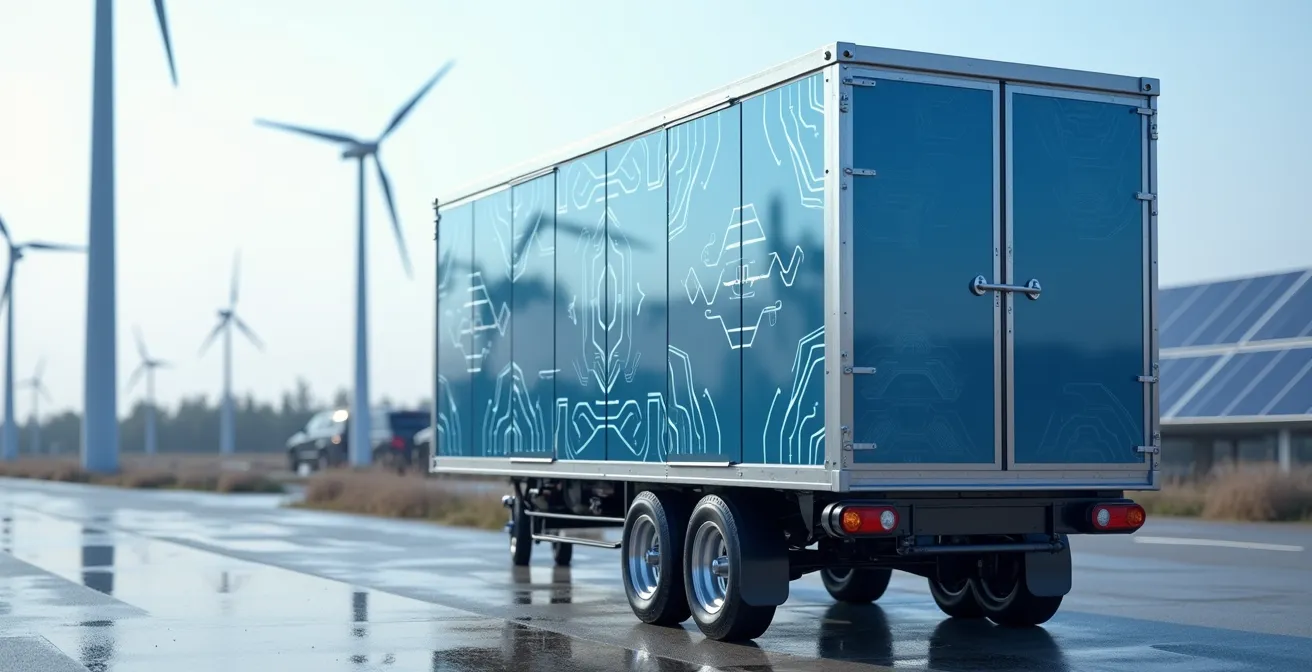
The conversation around portable power is rapidly shifting. Once seen merely as a cleaner, quieter substitute for diesel generators on construction sites or at outdoor events, the role of battery-based energy systems is undergoing a profound transformation. These sophisticated mobile energy storage solutions are now emerging as intelligent, dynamic assets capable of interacting with and stabilizing the very fabric of our electrical grid.
This evolution moves beyond simple, standalone power. We are now witnessing the rise of decentralized energy hubs on wheels, capable of delivering not just electricity, but also sophisticated grid services that enhance resilience, support renewable energy integration, and unlock entirely new economic models for a diverse range of industries.
Mobile power’s strategic edge
This article moves beyond the basics to reveal how mobile energy storage units are becoming crucial players in grid stabilization through services like peak shaving and frequency regulation. We explore the tangible ROI across diverse sectors by analyzing avoided costs and new revenue streams, and uncover novel applications in niche markets from filmmaking to disaster relief, all powered by a synergy with renewable technologies.
Mobile energy storage as dynamic grid stabilizers: Beyond standalone power
The true potential of mobile energy storage is unlocked when it ceases to be a passive power source and becomes an active participant in the energy ecosystem. These units can provide a suite of critical grid services that were once the exclusive domain of large, centralized power plants. This includes peak shaving, where they discharge power during high-demand periods to reduce strain on the grid, and frequency regulation, ensuring the grid’s operating frequency remains stable at 50 or 60 Hz.
By strategically deploying these mobile assets, grid operators can manage congestion in real-time, defer costly infrastructure upgrades, and more effectively integrate intermittent renewable sources like solar and wind. This capability is becoming increasingly vital, as evidenced by the 500% grid battery capacity surge between 2021 and 2024 in the US alone. This shift points toward a more flexible and resilient energy future.
What are grid services?
Grid services are specialized functions provided by energy assets to support the stability, reliability, and efficiency of the electrical grid. Key examples include frequency regulation, voltage support, and peak demand management.
This concept scales powerfuly with the creation of ‘virtual power plants’ (VPPs). A VPP is a network of decentralized, medium-scale power generating units, like mobile battery systems, that are aggregated and controlled by a central operator. This allows a fleet of mobile storage units to act in concert, providing the grid with significant capacity and flexibility on demand.

Through VPPs, mobile energy storage transforms from isolated equipment into a coordinated, revenue-generating network. This not only enhances grid resilience against disruptions but also provides a compelling economic incentive for businesses to invest in these versatile technologies, contributing to a more distributed and robust energy infrastructure.
Mobile BESS is a flexible and efficient way to optimize energy management and promote grid stability through backup power, demand response, and other critical services.
– Power Up Connect, Mobile BESS for Grid Services
The tangible returns: Deconstructing ROI for diverse mobile energy deployments
While the operational benefits are clear, the financial viability of mobile energy storage hinges on a comprehensive Return on Investment (ROI) analysis. This calculation extends far beyond simply comparing the cost of electricity to the price of diesel fuel. A true assessment must quantify avoided costs, such as generator rental and maintenance fees, grid connection charges for temporary sites, and potential penalties related to carbon emissions.
Furthermore, these systems unlock new revenue streams. By participating in the grid services mentioned earlier, owners can be compensated for helping to stabilize the grid. This dual benefit—cost avoidance and revenue generation—radically alters the economic equation, with some analyses showing a stark contrast in financial outcomes compared to traditional methods.
A direct comparison illustrates the financial upside of adopting Battery Energy Storage Systems (BESS) over legacy solutions like diesel generators.
| System Type | ROI Percentage | Investment Outcome | Total Investment |
|---|---|---|---|
| Battery Energy Storage System (BESS) | 22.5% | Profit of 22.5% | €1,110,080 |
| Diesel Electric Generator | -75% | Loss of 75% | €5.5 million fuel cost alone |
This favorable financial outlook is not an outlier; it reflects a broader trend where the total cost of ownership (TCO) for mobile BESS proves superior in many short- to medium-term applications. Industry-wide, expectations are high, with analysts projecting an 8-20% annual ROI for commercial energy storage systems. Analyses of industrial storage systems confirm this financial viability, noting that while initial costs are notable, the typical payback period is between three to six years, influenced by local energy policies and usage patterns.
To maximize these returns, operators can employ several key strategies that leverage the unique capabilities of battery storage technology.
Key ROI optimization strategies for mobile energy storage
- Step 1: Implement energy arbitrage by storing electricity when prices are low and discharging during peak pricing periods.
- Step 2: Utilize peak shaving to reduce facility peak power demand during high-load periods and lower demand charges.
- Step 3: Participate in grid service programs offering compensation for frequency regulation, voltage support, and spinning reserves.
- Step 4: Enable virtual power plant participation to aggregate systems for wholesale energy market access.
- Step 5: Calculate total cost of ownership including CapEx, OpEx, maintenance, and replacement costs over system lifecycle.
Unlocking unconventional power: Novel applications and niche markets for mobile energy storage
The flexibility and clean operation of mobile energy storage are opening doors to niche markets and unconventional applications where traditional power sources are impractical or prohibited. Industries that demand silence, reliability, and zero emissions are increasingly turning to these systems as an enabling technology, driving market expansion that reflects a projected 15.12% CAGR for the mobile energy storage systems market through 2032.
From powering remote scientific research facilities to energizing temporary data centers, the use cases are expanding rapidly. This adaptability is particularly evident in sectors like film production, which require significant, reliable power without the noise and fumes of diesel generators.
Hengdian film production mobile energy storage deployment
Wenergy deployed one of China’s largest mobile battery energy storage system projects in Hengdian, the nation’s premier film production hub. The 34.7MWh mobile energy storage fleet replaced diesel generators, delivering clean, silent, and reliable power for film crews. Phase I and II will reach 16.7MW / 34.7MWh in total capacity, serving multiple productions simultaneously during peak periods.
Beyond established industries, mobile BESS is becoming a cornerstone for future-forward concepts. Its ability to be deployed anywhere makes it ideal for creating pop-up charging hubs for autonomous vehicle fleets in remote areas or during special events, ensuring continuous operation without permanent infrastructure.
This same rapid-deployment capability makes mobile storage invaluable for disaster preparedness and humanitarian aid. When the grid fails, these units can be transported quickly to power emergency shelters, medical equipment, and communication hubs, providing a lifeline in critical situations. To see how innovation is reshaping industries, explore more technological innovations.
The unique requirements of various sectors highlight the versatility of mobile energy storage, each leveraging its core benefits for specific operational needs.
| Industry Sector | Power Requirements | Deployment Benefits | Key Applications |
|---|---|---|---|
| Mining Operations | High-output continuous | Remote site flexibility | Equipment power, ventilation systems |
| Film Production | 200kW with 250kW surge | Silent operation, emissions-free | Lighting, cameras, trailer power |
| Construction Sites | Variable load management | Portable, scalable deployment | Tools, temporary lighting, site power |
| Disaster Relief | 72-hour continuous supply | Rapid deployment capability | Emergency shelters, medical equipment |
Key Takeaways
- Mobile energy storage is evolving from a generator alternative to an active grid stabilization asset.
- True ROI extends beyond fuel savings to include avoided costs and new revenue from grid services.
- New applications in film, disaster relief, and mining are driving significant market growth and innovation.
- The synergy with portable renewables is creating fully self-sufficient, deployable energy ecosystems for any location.
The mobile-renewable nexus: Architecting self-sufficient energy ecosystems
The most powerful application of mobile energy storage lies in its synergy with portable renewable energy sources. By pairing mobile battery units with deployable solar trailers or compact wind turbines, it becomes possible to create entirely self-sufficient, resilient energy ecosystems that can operate anywhere, completely independent of the grid.
This combination provides a continuous, reliable power supply by storing excess energy generated during peak sun or wind and discharging it during lulls or at night. This “mobile microgrid” is a game-changer for remote industrial operations, military deployments, and off-grid communities seeking energy independence.
For Illinois communities transitioning to renewable energy, mobile storage serves as a crucial bridge between intermittent solar generation and consistent power demands. These systems can be rapidly dispatched to support grid stability during peak usage, provide emergency backup during outages, and enable efficient energy arbitrage.
– Illinois Renewable Energy Association, Mobile Energy Storage: The Power Grid’s New Secret Weapon
Technological advancements are set to accelerate this trend. The development of solid-state batteries promises higher energy density, improved safety, and longer lifecycles, making mobile units even more powerful and durable. A future underscored by the predicted 36.4% CAGR for the solid-state battery market from 2025-2033 will see more compact and efficient systems. These developments are central to the broader advancements in sustainable power.
Successfully integrating these components requires a systematic approach, ensuring that storage and generation work in harmony to deliver reliable power.
Steps to Integrate Mobile Storage with Renewable Energy Sources
- Step 1: Install bidirectional inverters that allow power to flow both ways for charging and discharging operations.
- Step 2: Deploy smart meters and control systems that communicate with utility networks for real-time monitoring.
- Step 3: Configure storage systems to charge during off-peak renewable generation periods when rates are low.
- Step 4: Program automatic discharge during peak demand periods to maintain grid stability and optimize arbitrage.
- Step 5: Integrate standardized connection ports and safety features to ensure compatibility with existing electrical systems.
- Step 6: Implement thermal management systems to optimize battery performance in varying environmental conditions.
Frequently Asked Questions on Mobile Energy Solutions
How do mobile energy storage systems integrate with renewable energy sources?
Mobile storage systems use bidirectional inverters and smart control systems to store excess renewable energy during peak production periods and discharge it when renewable generation is low or demand is high.
What are the advantages of solid-state batteries for mobile applications?
Solid-state batteries offer higher energy density, enhanced safety with reduced fire risk, longer lifecycles of 8,000-10,000 cycles compared to 1,500-2,000 for lithium-ion, and improved performance in extreme temperatures.
Can mobile storage systems operate independently from the grid?
Yes, mobile storage systems can function independently as microgrids, providing reliable power to remote areas and maintaining operations during grid outages or emergencies.
What is the typical deployment time for mobile energy storage units?
Most mobile energy storage systems can be deployed and operational within 30 minutes to a few hours, depending on the size and complexity of the installation.